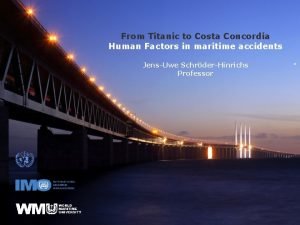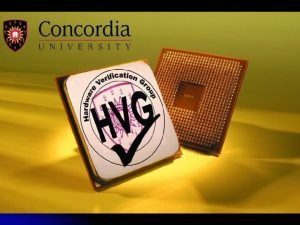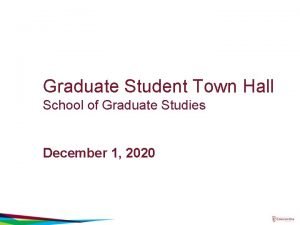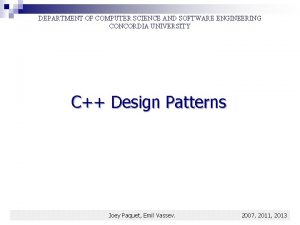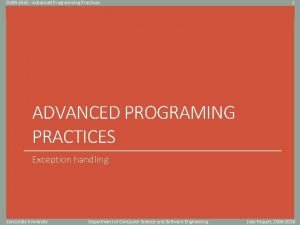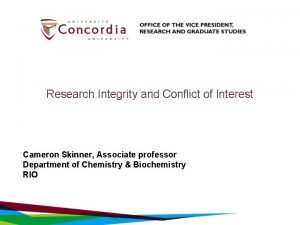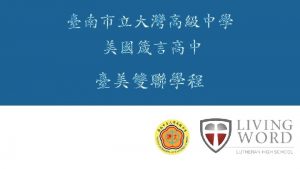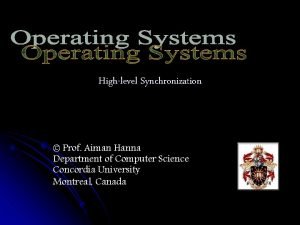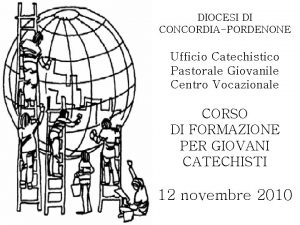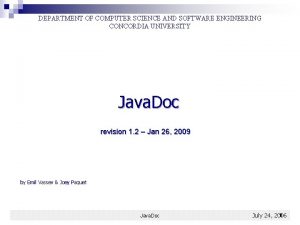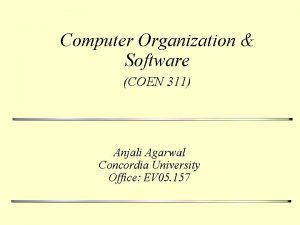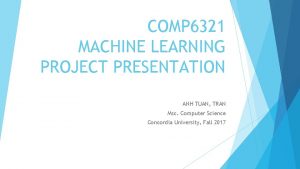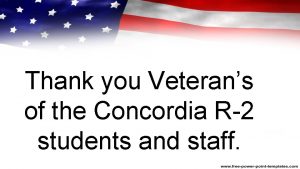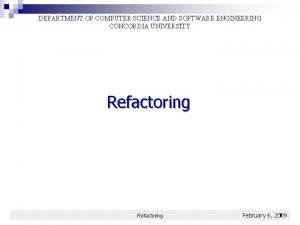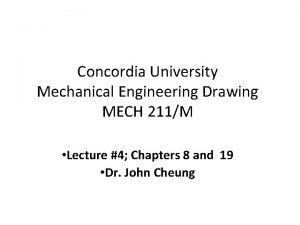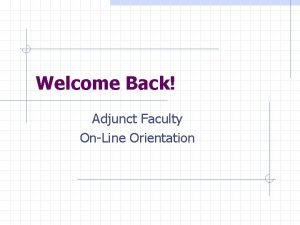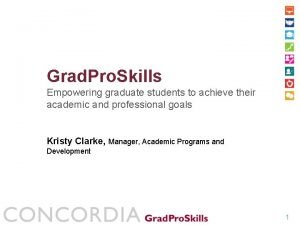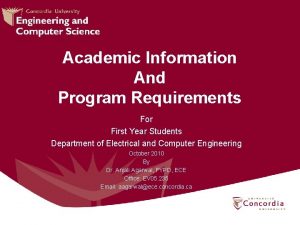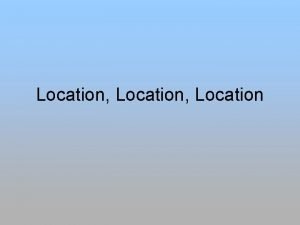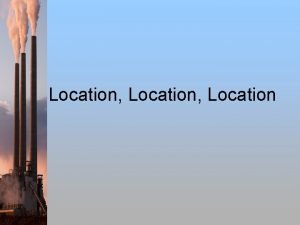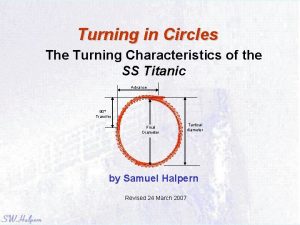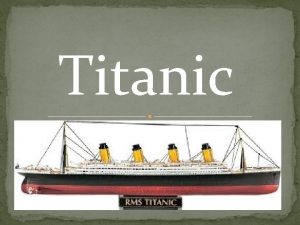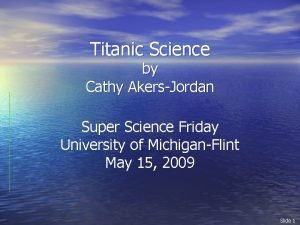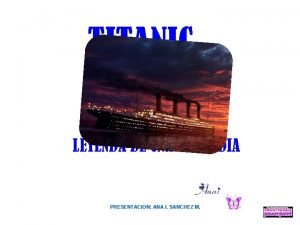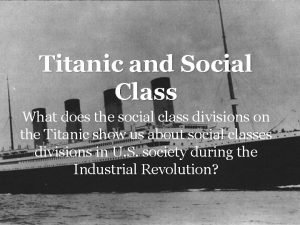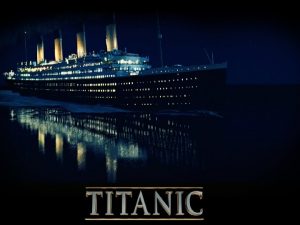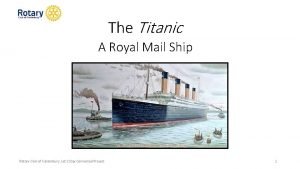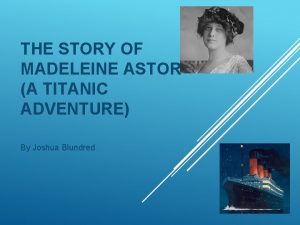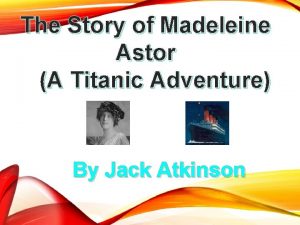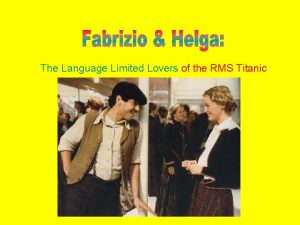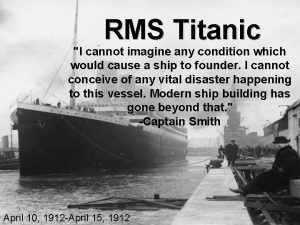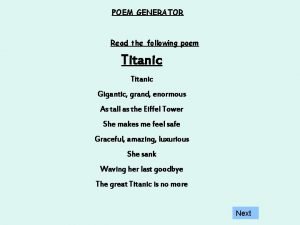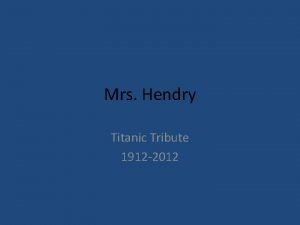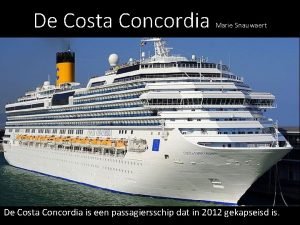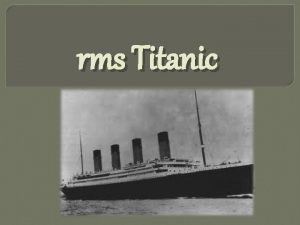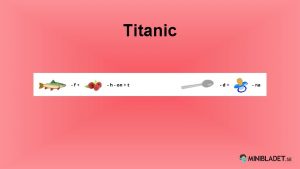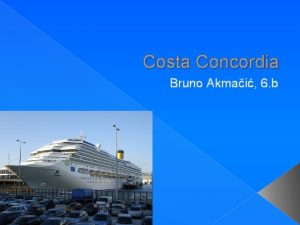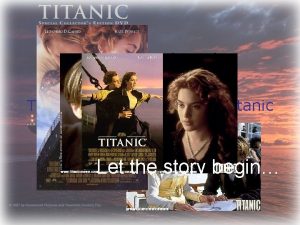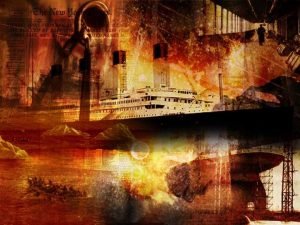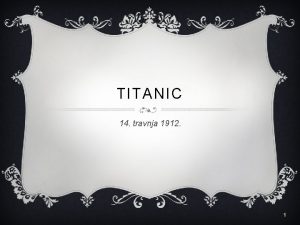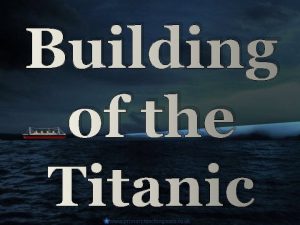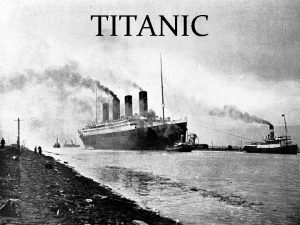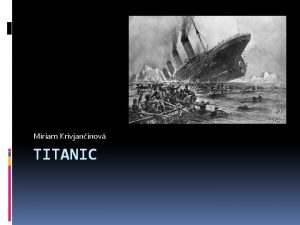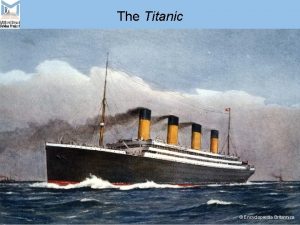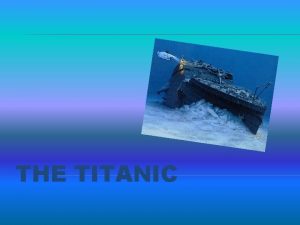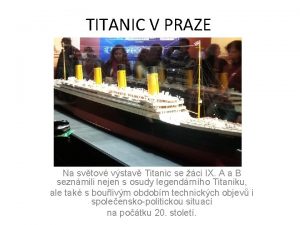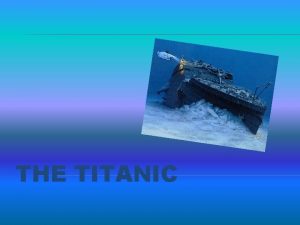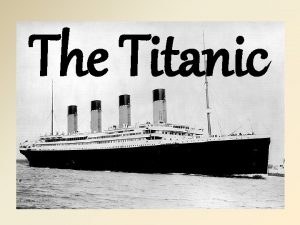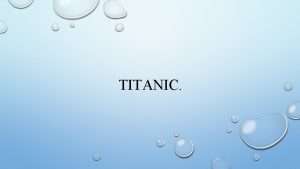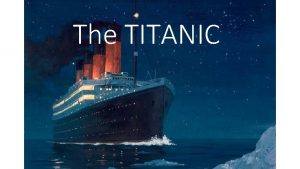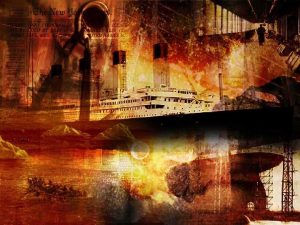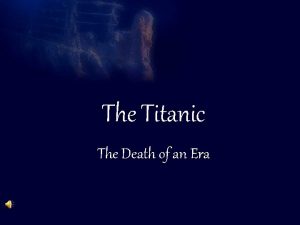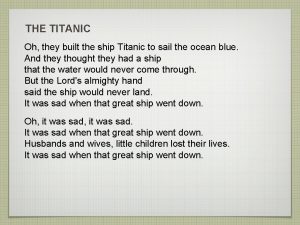From Titanic to Costa Concordia Human Factors in









































- Slides: 41

From Titanic to Costa Concordia Human Factors in maritime accidents Jens-Uwe Schröder-Hinrichs Professor IMCC Conference 2015, Dublin, Ireland 1

About WMU Maritime Post-graduate University Established by IMO in 1983 Focus on Maritime & Oceans Education, Research & Capacity. Building Principal Financial Supporters Government of Sweden City of Malmö Nippon Foundation, Japan IMCC Conference 2015, Dublin, Ireland 22

About the Presenter Dr. Jens-Uwe Schröder-Hinrichs – Professor (Nippon Foundation Chair of Maritime Administration) – Head, Maritime Safety and Environmental Administration (MSEA) – Head, Maritime Risk and System Safety (Ma. Ri. Sa) Research Group – Editor, WMU Journal of Maritime Affairs Areas of work/research – Implementation and enforcement of international maritime safety standards – Maritime accident investigations – Maritime risk assessment and management – Maritime human factors Links – Ma. Ri. Sa Group (http: //marisa. wmu. se) – WMU Journal (http: //www. springer. com/13437) IMCC Conference 2015, Dublin, Ireland 3

Human factors in maritime accidents … Roman fleet 255 BC Wasa 1628 4 Mount Blanc 1917 IMCC Conference 2015, Dublin, Ireland White Ship 1120

The example of the Costa Concordia (2012) (1) Report submitted to IMO’s MSC 92 § Human factor related key findings – “the Master’s unconventional behaviour … represents the main cause of the shipwreck. ” (p. 9) § Contributing from a human factor perspective – BRM related issues § No clear handover between Master and C/O § Inattention of Master due to other persons on the bridge § Inattentive bridge team § “… passive attitude of the Bridge Staff. Nobody seemed to have urged the Master … ot to give warning …” 5 IMCC Conference, Dublin, Ireland

The example of the Costa Concordia (2012) (2) Report submitted to IMO’s MSC 92 § Contributing from a human factor perspective – Emergency management § Unfamiliarity with the procedures to abandon the ship § Lack of leadership from the bridge § Dissoriented crew – Shipping company involvement § No questioning of the decisions of the Master § In appropriate cooperation with the SAR services § Qualification of the crew – e. g. communication problems 6 IMCC Conference, Dublin, Ireland

Similarities? (1) TITANIC (1912) § The ship’s track was 25 miles south of the area for field ice, but well within the area "Icebergs have been seen within this line in April, May and June. " (page 24) § Several sailing directions mention the danger resulting from ice in this area. (page 25) § Ice warnings were first received 48 hours before the accident and acknowledged. Several other warnings were received before the collision. (page 26 -28) § The master and the officers on watch were aware of the presence of ice in the vicinity of the ship. They expected to reach it before midnight (ship collided 23: 40). (page 29) § The officers were confident to identify ice in a safe distance from the ship (2 nd officer about the ice ". . . I judged I should see it (the ice) with sufficient distinctness and at a distance of a mile and a half, more probably two miles. "). (page 28) IMCC Conference 2015, Dublin, Ireland 7

Similarities? (2) TITANIC (1912) § The report makes reference to several reported conversations on the bridge between officers and the master about the ice and how likely it will be to see it under the given weather circumstances. (page 28 -29) § From tests made with a sister ship the report concludes that it would have required 37 seconds to change the course of the ship at an assumed speed of 22 knots to the extent made prior to the collision with the iceberg as it was testified during the investigation. This meant that the iceberg was sighted in a distance of approximately 450 meters off the ship (500 yards). (page 29, 30 -31) § The total capacity in the lifeboats was 1178 persons. There were 3560 life belts on board (page 18). The report lists 2201 persons on board - 885 crew and 1316 passengers. (page 23) IMCC Conference 2015, Dublin, Ireland 8

Similarities? (3) TITANIC (1912) vs. COSTA CONCORDIA (2012) § Both captains were very experienced and had immaculate service records prior to the accidents. They had spent their entire professional life at sea without larger accidents. § Both captains were aware of the potential dangers, but felt that the risks so small that they easily could be controlled – without the need of changes in speed and course. § In case of the TITANIC, no officer on the bridge objected to the navigation of the ship. So far, no information was published that officers on the COSTA CONCORDIA disagreed with the maneuvers of the captain. § Both accidents resulted into emergency situations for which the ships were not built (beyond design-base accidents). Both scenarios were considered as being highly unlikely. IMCC Conference 2015, Dublin, Ireland 9

Human factors reviewed Technology and regulations have changed, but human factors … § Possible Titanic factors – Authority gradient – Group think and the desire for harmony – Cognitive hysteresis – Efficiency thoroughness trade-offs (ETTO) – Organizational factors § Additional Non-Titanic factors – Communication 10 IMCC Conference 2015, Dublin, Ireland

Authority gradient (1) USCG CUYAHOGA (1978) 11 Pictures: WMU, www. uscg. mil The ability to challenge decisions taken on a higher level of authority IMCC Conference 2015, Dublin, Ireland

Authority gradient (2) USCG CUYAHOGA (1978) 12 Pictures: WMU, www. uscg. mil The ability to challenge decisions taken on a higher level of authority IMCC Conference 2015, Dublin, Ireland

Authority gradient (3) BOW MARINER (2004) GREEN LILY (1997). . . 13 Pictures: www. dieselduck. ca; MAIB IMCC Conference 2015, Dublin, Ireland

Group think or the desire for harmony … (1) BÖHLEN (1976) 14 Are critical comments appreciated. . . ? IMCC Conference 2015, Dublin, Ireland

Group think or the desire for harmony … (2) Picture: www. mirror. co. uk 15 . . . were they all in agreement? IMCC Conference 2015, Dublin, Ireland

Cognitive hysteresis (1) What do you see and what does it require to change this? 16 IMCC Conference 2015, Dublin, Ireland

Cognitive hysteresis (2) What do you see and what does it require to change this? 17 IMCC Conference 2015, Dublin, Ireland

Cognitive hysteresis (3) What do you see and what does it require to change this? 18 IMCC Conference 2015, Dublin, Ireland

Cognitive hysteresis (4) What do you see and what does it require to change this? 19 IMCC Conference 2015, Dublin, Ireland

Unanticipated side effects of new technology … (1) ANDREA DORIA vs. STOCKHOLM (1952) 20 New technologies and procedures change the system. . . IMCC Conference 2015, Dublin, Ireland

Unanticipated side effects of new technology … (2) ANDREA DORIA vs. STOCKHOLM (1952) 21 New technologies and procedures change the system. . . IMCC Conference 2015, Dublin, Ireland

Efficiency thoroughness trade-offs (ETTOs) (1) TORREY CANYON (1967) 22 How to balance operational priorities and safety concerns. . . IMCC Conference 2015, Dublin, Ireland

Efficiency thoroughness trade-offs (ETTOs) (2) TORREY CANYON (1967) 23 How to balance operational priorities and safety concerns. . . IMCC Conference 2015, Dublin, Ireland

Efficiency thoroughness trade-offs (ETTOs) (3) MSC Napoli (2007) 24 How to balance operational priorities and safety concerns. . . IMCC Conference 2015, Dublin, Ireland

How were human factors treated? § Often accidents were attributed to single causes § Reactive approaches in follow-up to an accident rather than proactive approaches in ship safety § Preferred way following accidents were technical regulations until the end of the 1990 s (double hull in case of the EXXON VALDEZ) § Changes in design, new regulations or training were suggested § A few examples only where the system as such was changed (HERALD OF FREE ENTERPRIZE – ISM Code) IMCC Conference 2015, Dublin, Ireland 25

Problem issue (1) – accident investigation & follow-up What safety problems are identified during accident investigation? (Schröder-Hinrichs et al. (2011)) ts 26 3. 5% Organizational influences 13. 9% Unsafe supervision 5. 7% Unsafe acts 20. 4% IMCC Conference 2015, Dublin, Ireland Preconditions for unsafe acts 56. 5% Co nt rib ut in g fa ct or s to ac ci d en Flag State influences

Problem issue (1) – accident investigation & follow-up Some of the issues not questioned by the investigators § Earlier passages § Training and qualifications of the crew § Emergency training § Working language § … IMCC Conference 2015, Dublin, Ireland 27

The search for single causes is often too simple A systemic view is required § Functional resonance 28 Source: Hollnagel (2004) IMCC Conference 2015, Dublin, Ireland

Problem issue (2) - Missing collective memory Why is the collective memory lacking? § Examples 29 – Communication problems on board Scandinavian Star (1988) IMCC Conference 2015, Dublin, Ireland Costa Concordia (2012)

Problem issue (2) - Missing collective memory Why is the collective memory lacking? § Examples 30 – Fire fighting training Angelina Lauro (1979) IMCC Conference 2015, Dublin, Ireland Carnival Splendor (2010)

Problem issue (2) - Missing collective memory Why is the collective memory lacking? § Examples 31 – Organizational influences Herald of Free Enterprize (1987) IMCC Conference 2015, Dublin, Ireland Sewol (2014)

The F/S Principle in Accident Investigation (Schröder-Hinrichs) The 3 F Loop There is no collective memory of the lessons that could be learnt Find Forget You look quickly at accidents Fix You do the sterotype follow up – changing a procedure, a checklist … The route to failure 32 IMCC Conference 2015, Dublin, Ireland You are frustrated and surprised if you do not see improvements or similar accidents happen in future

The F/S Principle in Accident Investigation (Schröder-Hinrichs) The potential 3 S Loop Sustain You follow up on the lessons learnt Search You carefully assess the learning potential of an accident Solve You look at the system and develop solutions in consulation with all parties affected and involved The route to success 33 IMCC Conference 2015, Dublin, Ireland You will see improvement in the overall safety performance

Problem issue (3) – organizational culture in shipping Types of organizational cultures in shipping companies (Mathiesen, 1994) Evasion culture § “When costs of complying with the Rules and Regulations is considered to be high, so are the benefits of evading them” 34 IMCC Conference 2015, Dublin, Ireland Compliance culture § “a situation where the shipowners strive to comply with Rules and Regulations as this is the ‘Ticket to Trade’” Safety culture § “a situation where owners are engaged in a continuous process to improve safety and see this as their management philosophy and operational mode to reduce losses” § “focus on the entire management chain; from the boardroom to the ship”

Problem issue (3) – organizational culture in shipping Work as imagined vs. work as done § How useful are the procedures and checklists that you use on your ships? § Do you know what your seafarers do on board? IMCC Conference 2015, Dublin, Ireland 35

Problem issue (3) – organizational culture in shipping A systemic view is needed § Ship and shore are part of the same system § There is a need to go beyond currently considered frameworks to foster a safety culture and to stimulate organizational learning – Issues to be considered, among others § Worker engagement § Ship-shore communication § Shore-staff training § … IMCC Conference 2015, Dublin, Ireland 36

Problem issue (3) – organizational culture in shipping How to handle maritime safety more effective § Key performance indicators – Tanker Management and Self Assessment – Intermanager KPIs Picture: Intermanager IMCC Conference 2015, Dublin, Ireland 37

Questions instead of a conclusion What can the insurance industry do to increase safety? § How is accident investigation by insurance carried out? § What is the focus of the accident investigation? § How are lessons from accidents treated? § How good do loss prevention programs work? IMCC Conference 2015, Dublin, Ireland 38

Any questions? Q&A Questions & Answers 39 IMCC Conference, Dublin, Ireland

Further information For more information regarding the issues addressed in this presentation, refer to § Schröder-Hinrichs J-U, Baldauf M, Ghirxi KT (2011) Accident investigation reporting deficiencies related to organizational factors in machinery space fires and explosions. Accident Analysis and Prevtion 43 (5): 1187– 1196 § Schröder-Hinrichs J-U, Hollnagel E, Baldauf M (2012) From Titanic to Costa Concordia—a century of lessons not learned. WMU Journal of Maritime Affairs 11 (2): 151 -167 40 IMCC Conference, Dublin, Ireland

Thank you! Many thanks to Erik Hollnagel for stimulating discussions related to the topic. Photo sources are acknowledged as much as it was possible to find the source of origin from the web. My apologies to the copyright holders if sources were not identified and displayed. This is not intentional. The views expressed in this presentation represents the personal view of the author and do not necessarily reflect the views of IMO or WMU. Contact 41 World Maritime University Dr. Jens-Uwe Schröder-Hinrichs Ma. Ri. Sa Research Group PO Box 500 201 24 Malmö Sweden Phone: +46 -40 -356 306 Email: jus@wmu. se www. wmu. se IMCC Conference 2015, Dublin, Ireland
 Titanic vs costa concordia
Titanic vs costa concordia Sofiene tahar
Sofiene tahar Mystudentcenter concordia
Mystudentcenter concordia Software engineering concordia
Software engineering concordia Soen 6441
Soen 6441 Cameron skinner concordia
Cameron skinner concordia Concordia international school hk
Concordia international school hk Aiman hanna
Aiman hanna Diocesi concordia pordenone ufficio catechistico
Diocesi concordia pordenone ufficio catechistico Software engineering concordia
Software engineering concordia Anjali agarwal concordia
Anjali agarwal concordia Machine learning project presentation
Machine learning project presentation Concordia r2
Concordia r2 Software engineering concordia
Software engineering concordia Concordia university mechanical engineering
Concordia university mechanical engineering Banweb concordia
Banweb concordia Graziano diritto canonico
Graziano diritto canonico Hay quien pretende ser rico y no tiene nada
Hay quien pretende ser rico y no tiene nada Concordia grad pro skills
Concordia grad pro skills Concordia originality form
Concordia originality form Site factors vs situation factors
Site factors vs situation factors Is wood biotic or abiotic
Is wood biotic or abiotic Abiotic vs biotic factors
Abiotic vs biotic factors Abiotic factors and biotic factors
Abiotic factors and biotic factors Is mud abiotic or biotic
Is mud abiotic or biotic Losch zone of profitability
Losch zone of profitability Factors od 18
Factors od 18 What are the factors of 7
What are the factors of 7 Factors of 8 and 24
Factors of 8 and 24 The turning circle of a ship is the path followed by the
The turning circle of a ship is the path followed by the Titanic steckbrief
Titanic steckbrief Titanic path
Titanic path Que dia partio el titanic
Que dia partio el titanic Social class titanic
Social class titanic Titanic watertight compartments
Titanic watertight compartments Titanic rudder
Titanic rudder Madeline astor
Madeline astor Madeleine astor titanic
Madeleine astor titanic Helga titanic
Helga titanic Imagine titanic
Imagine titanic 20 line poem generator
20 line poem generator Victorine chaudanson
Victorine chaudanson
